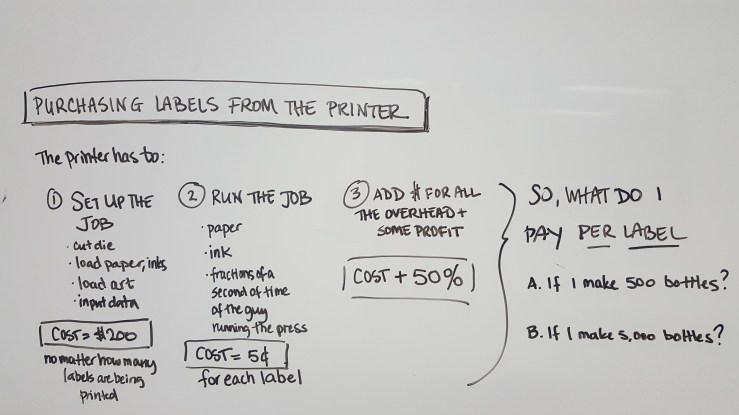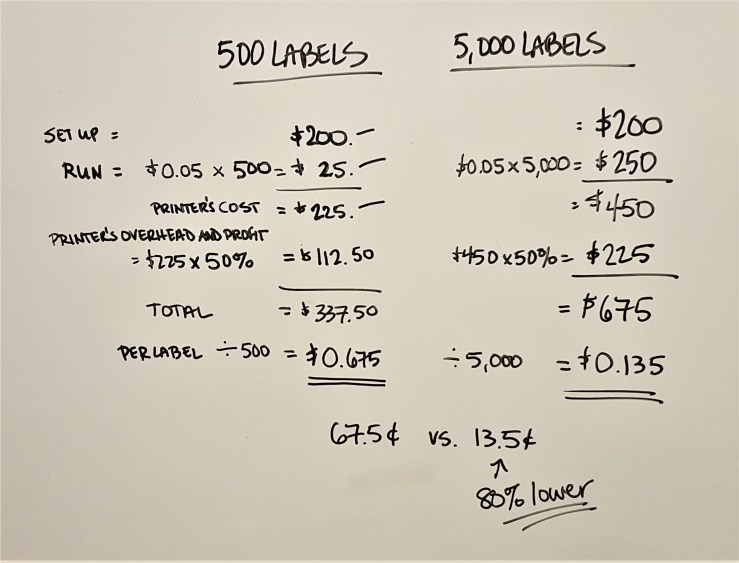Living a mile up a dead-end dirt road in an area that has more cows than people presents a few challenges when you start a garage, or in this case basement, business. Things like how does an 18-wheeler truck delivering a pallet of bottles actually get to your place? The answer: very carefully, with a lift gate, and not during Mud Season. Or being stuck with satellite internet that goes out every time it rains hard (although interestingly not when there’s a blizzard of snow), and did I mention no cell service? There’s one spot on the property where we can get cell service, which is out on the road about 200 ft. from the barn. Every time you drive up the road from the rural highway and hit that spot, you get a text message that says ‘Welcome Abroad’. Did I mention we are 8 miles from Canada? So it’s a good thing this isn’t a tech start up.
Back to said pallet of bottles. Everything in manufacturing is delivered on pallets, those ubiquitous slatted wooden 40 x 48 inch, 6 inch high frames that are like little mobile pieces of floor. You can pack anything on to them, and people do: bottles, cartons, corks, cleaning supplies, tanks, machinery…finished cases of ice cider. A pallet is like a unit of measure. Don’t ever buy a pallet and a 1/4 of something. You’ll pay almost as much in trucking cost for the 1/4 as you will for the full one. The cost per pallet of anything will be lower per unit than the cost per unit of some lesser amount. If you are buying more than one pallet, as long as you keep buying by the pallet, you don’t usually see the cost per unit get lower until you buy a full trailer load. Then if you are buying by the trailer load on a regular basis, you can usually get stuff even cheaper. This is just one factor among all the various economies of scale that affect every aspect of business.

I think many people would like to pretend that economies of scale don’t exist, or that somehow it’s an economic theory that is just a theory with which you can choose to disagree. Unfortunately that’s not the case. Economies of scale are in everything, because some costs or resources just don’t increase 1 to 1 with an increase in quantity. Labels are a great example. For a label printer, there’s a significant amount of cost involved in setting up a print job, and it doesn’t make much difference whether the print job is for 500 labels or for 5,000 labels. Once the job is set up, the incremental cost of printing 501 labels vs. 500 labels is pretty much just the cost of the ink and the paper for the one extra label – probably less than 5 cents, but let’s assume it’s 5 cents. If it costs $200 to set up the job, it’s going to cost $200 + 500 x $0.05 to print the labels, or $225. Add some % to cover the printer’s overhead and profit, say 50%, and the price you will pay for 500 labels is $337.50 ($225 x 1.5). That works out to 67 1/2 cents ($0.675) per label. On the other hand if you print 5,000 labels, the printer’s cost is $200 + 5,000 x $0.05, or $450, the price you will pay is $675.00 ($450 x 1.5), and that works out to $0.135 per label. That is an 80% decrease in the cost per label!


The larger the ratio of fixed (set up cost in this example) to variable cost (ink and paper) in a process, the more significant the economies of scale. And they are everywhere. A 620 Liter stainless steel wine tank costs $2,295, a 1,100L one costs $3,095 – a 35% increase in price for a tank that will hold 77% more volume. A 500g package of commercial yeast will cost you more per g than if you buy a 2kg package. A pallet of bottles will cost you more per bottle than if you buy them by the trailer load. Brochures, corks, capsules, even office paper for god’s sake. It’s relentless. And these amounts that I’m giving as examples are still tiny in the overall context of the cider market. Imagine how much lower the cost to produce a bottle of cider – any cider, or beer or wine for that matter – is for a 600,000 gallon operation vs a 6,000 gallon operation, just by virtue of being 100 times larger in quantity. How can a small producer hope to compete?
That’s what we are going to explore more…

Tell the cell phone company they can put up a tower on your farm! You’d get a good connection and they’d pay you to have it there. This fall, I went to a high school football game and they had a cell phone tower next to the field. It held the lights.
On a different note, i’m digging the blog so far. Interesting stuff…even for those like me that aren’t in the industry.
LikeLike
Thank you! Rural Vermont has way more hills and way fewer people. The cell service providers can’t make it work economically – need more towers per square mile for many fewer customers per square mile. Damn economics!!
I’m glad you’ve enjoyed this so far. Let me know if it starts getting boring!
LikeLike
How about the potential of cooperatives to help overcome Issues of economy of scale?
LikeLike
A wonderful and complex topic Autumn! The more effective a cooperative is at overcoming economies of scale, the more rigid and uniform the participants have to be. For purchasing, everyone has to order the same thing to get the purchasing benefits. For production, people need to use the same methods, and somehow work out the priorities in a ‘fair’ manner. Milk cooperatives work because it’s a uniform ‘commodity’ product. Or in France there are town ‘commune’ wine producers – everyone brings their grapes and they turn out one standard batch of wine in a shared facility. At some point if you want to produce a differentiated product, outsourcing on contract to a large scale operator gives you a good measure of the benefits of scale without having to ‘give up’ as much of what makes your product special, and avoiding the burden of negotiating everything among multiple parties all the time. In cider, the pressing step is a good part of the value chain to consider that. Marketing cooperatives may be the most effective while still allowing, encouraging individual producer diversity, although within a set of definable ‘standards’. Your thoughts?
LikeLike